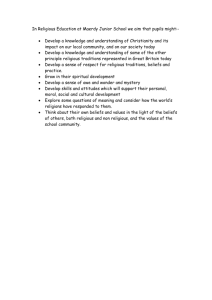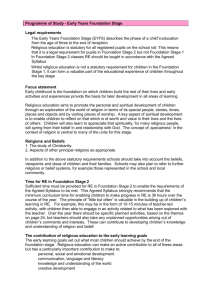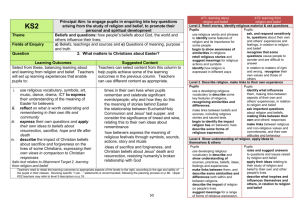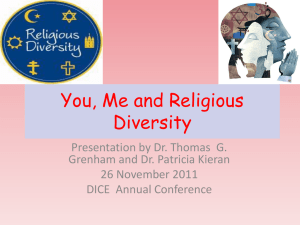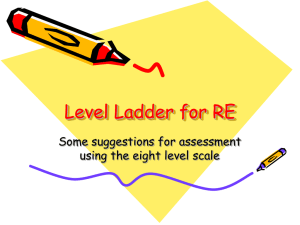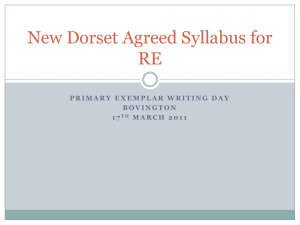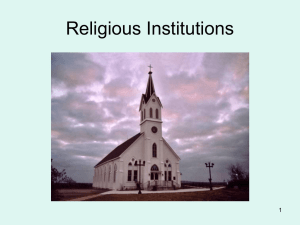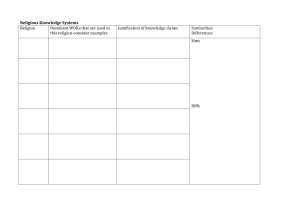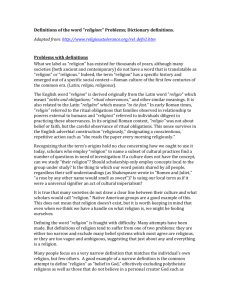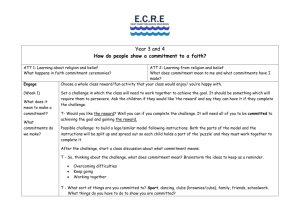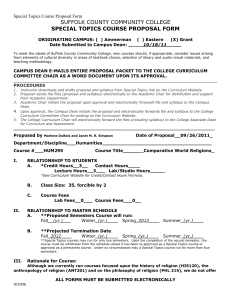RE Skills Matrix
advertisement
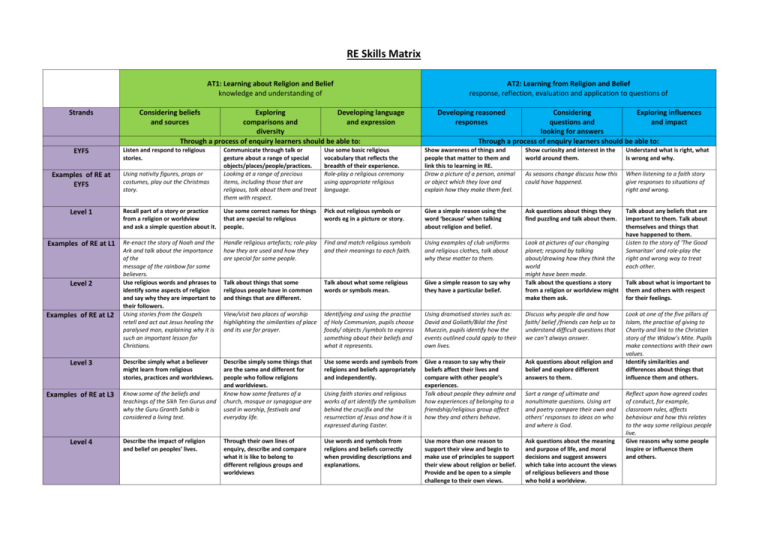
RE Skills Matrix AT1: Learning about Religion and Belief knowledge and understanding of Strands EYFS Examples of RE at EYFS Considering beliefs and sources Exploring Developing language comparisons and and expression diversity Through a process of enquiry learners should be able to: Listen and respond to religious stories. Using nativity figures, props or costumes, play out the Christmas story. AT2: Learning from Religion and Belief response, reflection, evaluation and application to questions of Developing reasoned responses Considering Exploring influences questions and and impact looking for answers Through a process of enquiry learners should be able to: Communicate through talk or gesture about a range of special objects/places/people/practices. Looking at a range of precious items, including those that are religious, talk about them and treat them with respect. Use some basic religious vocabulary that reflects the breadth of their experience. Role-play a religious ceremony using appropriate religious language. Show awareness of things and people that matter to them and link this to learning in RE. Draw a picture of a person, animal or object which they love and explain how they make them feel. Show curiosity and interest in the world around them. Understand what is right, what is wrong and why. As seasons change discuss how this could have happened. When listening to a faith story give responses to situations of right and wrong. Talk about any beliefs that are important to them. Talk about themselves and things that have happened to them. Listen to the story of ‘The Good Samaritan’ and role-play the right and wrong way to treat each other. Level 1 Recall part of a story or practice from a religion or worldview and ask a simple question about it. Use some correct names for things that are special to religious people. Pick out religious symbols or words eg in a picture or story. Give a simple reason using the word ‘because’ when talking about religion and belief. Ask questions about things they find puzzling and talk about them. Examples of RE at L1 Re-enact the story of Noah and the Ark and talk about the importance of the message of the rainbow for some believers. Use religious words and phrases to identify some aspects of religion and say why they are important to their followers. Using stories from the Gospels retell and act out Jesus healing the paralysed man, explaining why it is such an important lesson for Christians. Handle religious artefacts; role-play how they are used and how they are special for some people. Find and match religious symbols and their meanings to each faith. Using examples of club uniforms and religious clothes, talk about why these matter to them. Talk about things that some religious people have in common and things that are different. Talk about what some religious words or symbols mean. Give a simple reason to say why they have a particular belief. Look at pictures of our changing planet; respond by talking about/drawing how they think the world might have been made. Talk about the questions a story from a religion or worldview might make them ask. View/visit two places of worship highlighting the similarities of place and its use for prayer. Identifying and using the practise of Holy Communion, pupils choose foods/ objects /symbols to express something about their beliefs and what it represents. Using dramatised stories such as: David and Goliath/Bilal the first Muezzin, pupils identify how the events outlined could apply to their own lives. Discuss why people die and how faith/ belief /friends can help us to understand difficult questions that we can’t always answer. Level 3 Describe simply what a believer might learn from religious stories, practices and worldviews. Use some words and symbols from religions and beliefs appropriately and independently. Know some of the beliefs and teachings of the Sikh Ten Gurus and why the Guru Granth Sahib is considered a living text. Give a reason to say why their beliefs affect their lives and compare with other people’s experiences. Talk about people they admire and how experiences of belonging to a friendship/religious group affect how they and others behave. Ask questions about religion and belief and explore different answers to them. Examples of RE at L3 Describe simply some things that are the same and different for people who follow religions and worldviews. Know how some features of a church, mosque or synagogue are used in worship, festivals and everyday life. Through their own lines of enquiry, describe and compare what it is like to belong to different religious groups and worldviews Use words and symbols from religions and beliefs correctly when providing descriptions and explanations. Use more than one reason to support their view and begin to make use of principles to support their view about religion or belief. Provide and be open to a simple challenge to their own views. Ask questions about the meaning and purpose of life, and moral decisions and suggest answers which take into account the views of religious believers and those who hold a worldview. Level 2 Examples of RE at L2 Level 4 Describe the impact of religion and belief on peoples’ lives. Using faith stories and religious works of art identify the symbolism behind the crucifix and the resurrection of Jesus and how it is expressed during Easter. Sort a range of ultimate and nonultimate questions. Using art and poetry compare their own and others’ responses to ideas on who and where is God. Talk about what is important to them and others with respect for their feelings. Look at one of the five pillars of Islam, the practise of giving to Charity and link to the Christian story of the Widow’s Mite. Pupils make connections with their own values. Identify similarities and differences about things that influence them and others. Reflect upon how agreed codes of conduct, for example, classroom rules, affects behaviour and how this relates to the way some religious people live. Give reasons why some people inspire or influence them and others. Examples of RE at L4 Examine how the Buddha’s journey to enlightenment shapes the lives of practising Buddhists. Explore the observation and practise of the Sabbath in Jewish, Muslim and Christian homes. Using the important symbol of light, explore Diwali, Chanukah and the significance of Jesus’ ‘light of the world’ statement, making connections across the religions. Level 5 Develop their own lines of enquiry and explain how religious sources and evidence are used by religious believers to provide answers to questions about life and morality. Use an increasingly wide range of vocabulary and symbolism from different religions and world views when providing explanations. Examples of RE at L5 Examine the experience of suffering in and between faiths and how it significantly affects believers in their everyday actions. Where Buddhists believe that personal desire causes suffering, Hindus embrace Karma’ other faiths look to different explanations including illness and natural disasters. Suggest reasons for similarities and differences in beliefs within religions as well as between religions. Consider a range of worldviews relating to questions about life and morals. Explore and explain the significance/ importance of repentance in faith groups and how it is observed through diverse practices in religious festivals, e.g., Lent, Yom Kippur and Ramadan. Using the biblical events of the Last Supper and decoding the symbolism of Leonardo DaVinci’s painting, explore and compare the significant impact on the lives of Christians today. Generate enquiry through investigating the 5 K’s, pupils consider how these objects might reinforce a Sikh’s sense of identity and belonging.Pupils suggest symbols which might represent their own identity and suggest where they belong, or which might summarise prior learning of another faith. Give reasons for more than one point of view, providing several pieces of evidence to these views e.g. a quotation, personal experience. Looking at creation theories, explore, a faith response a scientific view and their own ideas. Share own opinions about respect for animals and show an understanding of why some religious people hold differing views about eating meat. Develop their own lines of enquiry and explain some of the challenges a believer may have when following their religion or worldview. Explain their own views on life’s big questions, referring to who or what inspires and influences them. Investigate the religious practice of pilgrimage and Holy site visits for believers and how it can reinforce their spirituality and religious identity. Discuss whether nonbelievers need a tangible focus to reinforce their identity. Explore questions about the human soul and in the context of the Holocaust and subsequent genocides, discuss why people respond differently. Examine and respond to the moral and ethical views on preparing food focussing on Halal or Kosher and the Buddhist concept of mindfulness.
